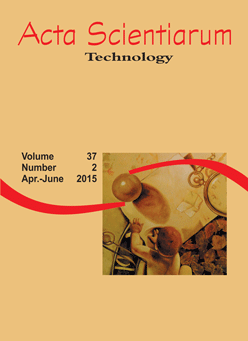<b>Sensory profile of beef burger with reduced sodium content
DOI:
https://doi.org/10.4025/actascitechnol.v37i2.25224Palavras-chave:
meat products, sensory analysis, quantitative descriptive analysis, principal component analysis, sodium chloride, potassium chloride.Resumo
This study determined the sensory profile of three beef burger samples, namely, CON (control), F25 (25% sodium reduction) and F50 (50% sodium reduction), based on the Quantitative Descriptive Analysis (QDA). The samples´ microbial, physical and chemical composition was evaluated. Twelve panelists were selected and trained using as criteria the panelists´ discrimination power, reproducibility and consensus. Eleven terms were generated by the method of network descriptors. The intensity of each descriptor in each sample was evaluated by unstructured scale of 9 cm. Data were analyzed by ANOVA, Duncan´s mean test and principal component analysis. The sensory profile shows that low sodium beef burgers had lower fat and salty flavor when compared to untreated control and greater flavor and spice aroma. The above proves that reducing sodium intake causes increased perception burger tasters when compared to the presence of spices in the product. Treatment with 50% sodium reduction obtained the best results for texture softness and appearance. There was no significant difference (p < 0.05) in the chemical composition of ash, protein and fat in all burgers. In the case of general sensory attributes, treatments with sodium reduction obtained higher intensities of the attributes evaluated, except for meat and salt flavors.
Â
Downloads
Downloads
Publicado
Como Citar
Edição
Seção
Licença
DECLARAÇíO DE ORIGINALIDADE E DIREITOS AUTORAIS
Declaro que o presente artigo é original, não tendo sido submetido í publicação em qualquer outro periódico nacional ou internacional, quer seja em parte ou em sua totalidade.
Os direitos autorais pertencem exclusivamente aos autores. Os direitos de licenciamento utilizados pelo periódico é a licença Creative Commons Attribution 4.0 (CC BY 4.0): são permitidos o compartilhamento (cópia e distribuição do material em qualqer meio ou formato) e adaptação (remix, transformação e criação de material a partir do conteúdo assim licenciado para quaisquer fins, inclusive comerciais.
Recomenda-se a leitura desse link para maiores informações sobre o tema: fornecimento de créditos e referências de forma correta, entre outros detalhes cruciais para uso adequado do material licenciado.















